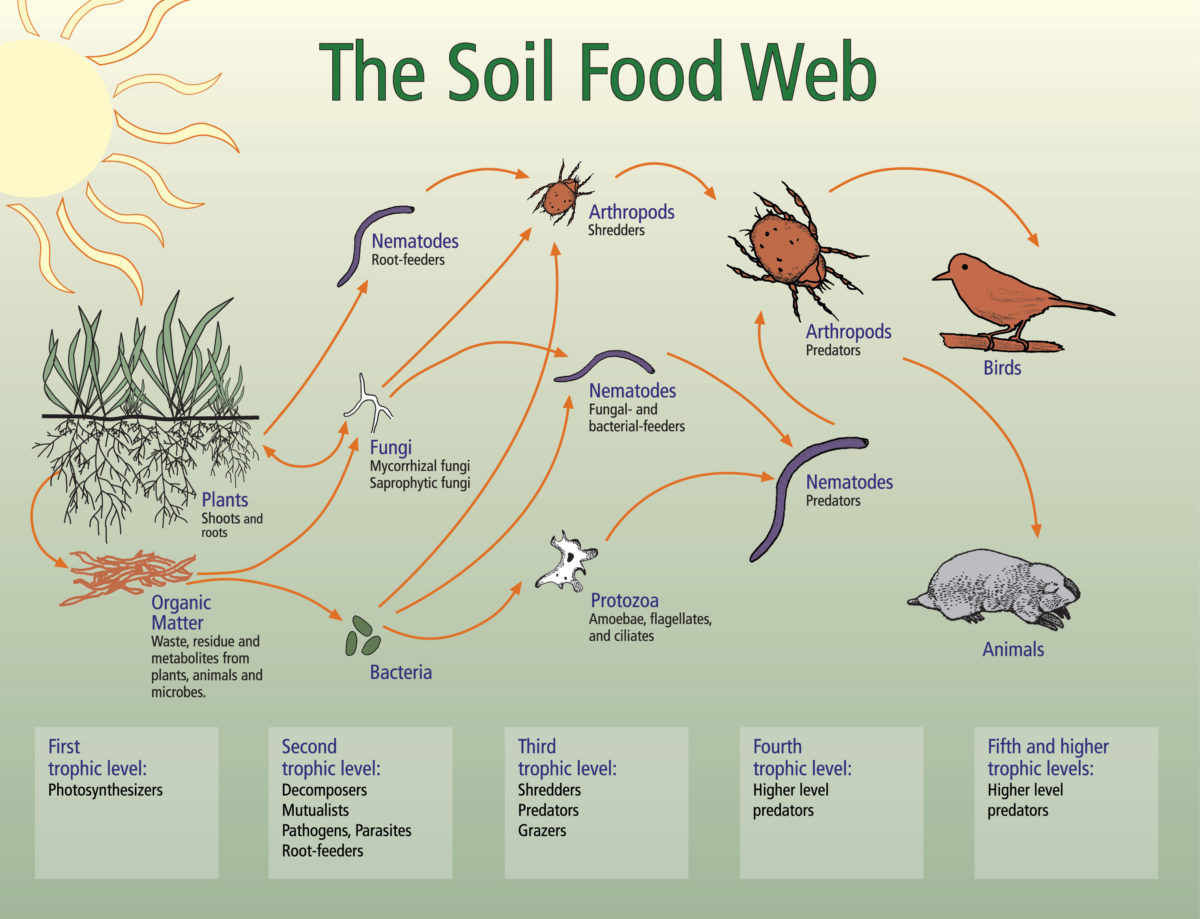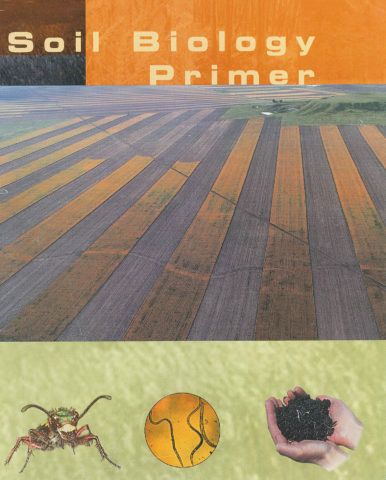
All plants depend on the soil food web for their nutrition. Soil and Water Conservation Society.
At In Harmony, we talk a lot about building healthy soil. But what does that mean?
Take a moment to consider: soil is alive. It is not just the dirt under your fingernails. Soil is teeming with tiny critters that work to keep plants healthy.
Unfortunately, many urban soils are not very healthy. Heavy machinery used by developers and builders may have scraped off rich topsoil. Soils may have been damaged from chemical fertilizers or runoff from streets and driveways. Pesticides that kill bugs, weeds and diseases may have killed beneficial critters too.
We believe that healthy soil is key for a healthy landscape. When we install a new landscape, we amend the soil so new plants get off to a good start. In established landscapes, our service technicians use mulch, compost tea and similar products. These products add organic matter to the landscape and feed soil organisms.
Keeping plants healthy
The Saving Water Partnership says soil organisms work to keep plants healthy by:
- Supplying balanced nutrients to growing plants
- Fighting plant diseases and pests
- Storing fertilizers and natural nutrients for gradual release, while preventing them from washing into streams
- Storing water, which reduces runoff and your garden’s irrigation needs
- Making clay soils better drained and easier to work
- Trapping and breaking down pesticide residues and polluted runoff
What is the soil food web?
The soil food web is the community of organisms living all or part of their lives in the soil. All plants—grass, trees, shrubs, agricultural crops—depend on the food web for their nutrition.
Soil microorganisms include tiny one-celled bacteria, algae, fungi and protozoa. Somewhat larger soil organisms include nematodes, micro-arthropods, earthworms, insects and small vertebrates.
“As these organisms eat, grow and move through the soil, they make it possible to have clean water, clean air, healthy plants and moderated waterflow,” according to Soil Biology Primer.
Organic matter fuels the food web. Compost, mulch, compost tea, leaves, grass clippings, composted manure and wood chips all supply food for the soil food web to use.
Meet the food web
The Soil Biology Primer has a great introduction to the organisms that make up the food web. The information below comes directly from the primer.
Bacteria
Bacteria are very tiny, one-celled organisms, about 4/100,000 of an inch wide. A teaspoon of productive soil generally contains between 100 million and 1 billion bacteria.
How bacteria enhance soil quality
- Feed other members of the food web
- Decompose organic matter
- Help keep nutrients in the rooting zone and out of surface and groundwater
- Enhance soil structure, improving the flow of water and reducing erosion
- Compete with disease-causing organisms
- Filter and degrade pollutants as water flows through soil
Soil fungi
Fungi are microscopic cells. They usually grow as long threads or strands called hyphae. They sometimes group into networks called mycelium. Many plants depend on fungi to help extract nutrients from the soil.
How fungi enhance soil quality
- Decompose complex carbon compounds
- Improve accumulation of organic matter
- Retain nutrients, reducing leaching of nutrients out of the root zone
- Bind soil particles into aggregates
- Improve plant growth
- Compete with plant pathogens
- Decompose some types of pollutants
Protozoa
Protozoa are single-celled animals. They mostly feed on bacteria. They are several times larger than bacteria, ranging from 1,5000 to 1/50 of an inch in diameter.
There are three groups of protozoa. Ciliates are the largest. They move by means of hair-like cilia. Amoebae move by means of a temporary foot or “pseudopod.” Flagellates use a few whip-like flagella to move.
How protozoa enhance soil quality
- Release excess nitrogen that can be used by plants and other members of the food web
- Increase decomposition rates and soil aggregation
- Prevent some pathogens from establishing on plants
- Provide prey for large soil organisms, such as nematodes
Soil nematodes
Nematodes are non-segmented worms. They are about 1/500 of an inch in diameter and 1/20 of an inch in length. Some nematodes are responsible for plant diseases. But most nematodes perform beneficial roles in soil.
How nematodes enhance soil quality
- Regulate the populations of other soil organisms
- Mineralize nutrients into forms that can be used by plants
- Provide a food source for other soil organisms
- Eat disease-causing organisms
Soil arthropods
Many bugs, known as arthropods, make their home in the soil. They range in size from microscopic to several inches in length. They include:
- Insects, such as springtails, beetles and ants
- Crustaceans, such as sowbug
- Arachnids, such as spiders and mites
- Myriapods, such as centipedes and millipedes
- Scorpions
Arthropods may be shredders, predators, herbivores or fungal feeders. Several thousand different species of arthropods may live in a square mile of forest soil.
How arthropods enhance soil quality
- Improve soil structure through burrowing and creating fecal pellets
- Control disease-causing organisms
- Stimulate microbial activity
- Enhance decomposition through shredding of large plant litter and mixing of the soil
- Regulate healthy soil food web populations
Earthworms
Most people know earthworms. There are more than 7,000 species of earthworms, ranging from an inch to two yards in length.
How earthworms enhance soil quality
- Shred and increase the surface area of organic matter, thus stimulating microbial decomposition and nutrient release
- Improve soil stability, porosity and moisture-holding capacity by burrowing and aggregating soil
- Turn soil over, prevent disease and enhance decomposition by bringing deeper soil to the surface and burying organic matter
- Improve water infiltration by forming deep channels and improving soil aggregation
- Improve root growth by creating channels lined with nutrients
Other aspects of soil
We will cover other aspects of soil in a future blog post:
- Soil texture: clay, sandy or loamy
- Soil pH
- Soil structure
- Air and water in soil

